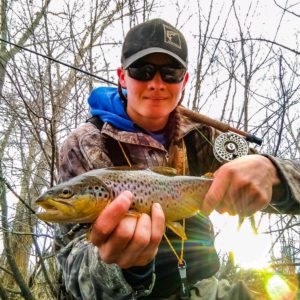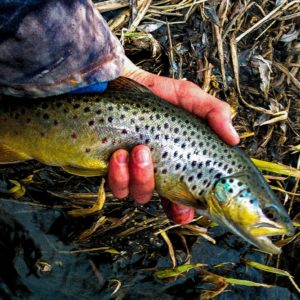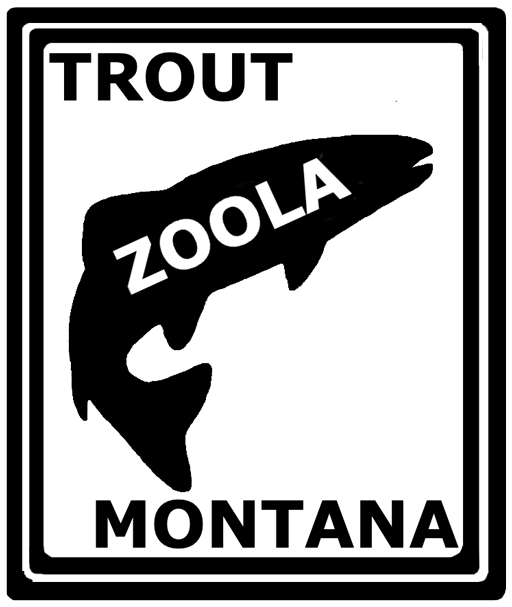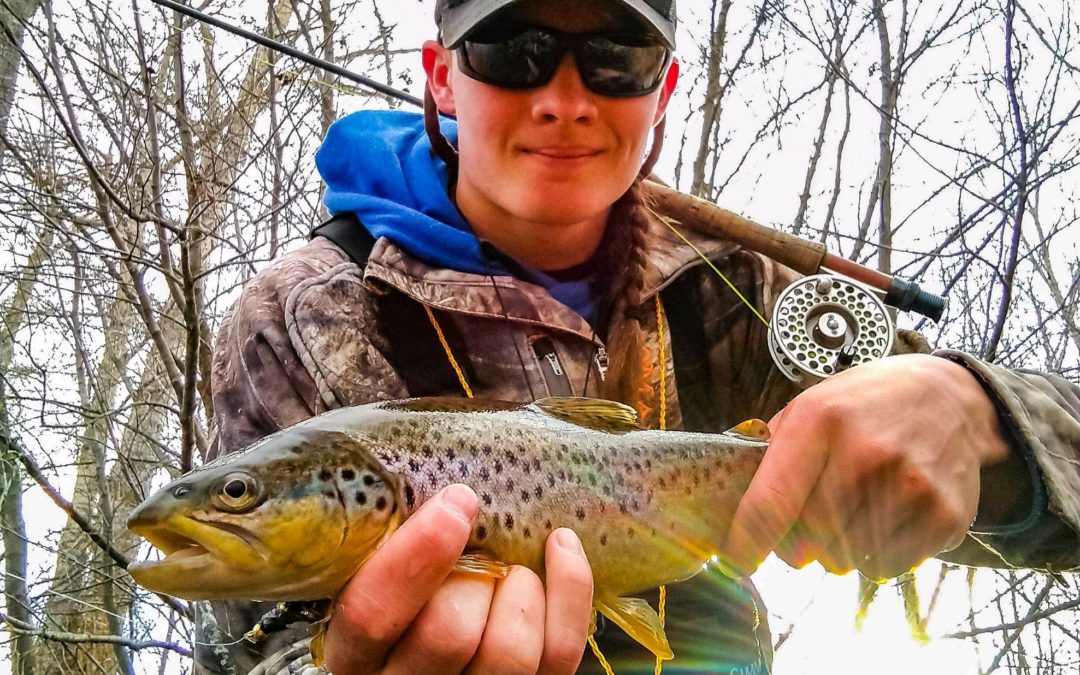
Our 18 year old boy wrote a narrative for his High School Senior English class today. Here is what he encountered and wrote about following his day living minutes away from the Bitterroot river, Stevensville MT.
Pride Jessen
English 12
Mrs. Sager
2/24/20
Searching for Gold on Small Water
The second hand of the clock in my 6th period study hall seems to move in slow motion. It feels like I’ve been here for an eternity. I glance out the window to see beautiful blue skies above the Sapphire Mountains. It’s a warm day, unusual for February in Western Montana. I shift about anxiously in my chair. Because days like this are so rare in winter, I wish to take full advantage of this opportunity. Today will be a good day for fishing. I can picture my nine foot, five weight fly rod in the back seat of my pickup truck. It’s as though I can already feel my hand on the cork, feeding line from the reel. That will have to wait, at least until the bell rings. When it finally does, I practically jump from my seat and set off immediately for the parking lot. The engine of my f150 comes to life as my stereo resumes my cranberries CD, halfway through one of my favorite tracks. I want to be on the water as soon as possible, but I need to stop at home first for flies and waders. I know it won’t take long.
Shortly after pulling into the driveway, I discover my flybox has a shortage of san juan worms. The san juan is sort of a last ditch effort to catch fish. I only use them when all else fails. They are by no means my favorite fly to fish, but it really isn’t my decision. It’s all about what the fish want, and in winter, they want worms. So, I set up my vice and gather my materials. I only need three hooks and beads, that should be plenty for today. What follows is the process of combining the hook, bead, rubber, thread, and dubbing in such a way that it perfectly resembles a small worm caught in moving water. It doesn’t take me long. I am a novice tyer at best, but san juans are relatively easy to tie. Less than twenty minutes after the 6th period bell, I’m already back in my truck, waders on, flies tied, ready to find out exactly where the brownies are lurking.
I arrive at my fishing spot, a small tributary of the Bitterroot. With experienced hands, I set up the fly rod, and tie on a new leader. I place a strike indicator roughly a wingspan above my fly. Now it’s show time. The first good hole is about a half mile upstream. It’s a workout to fight the current, but the creek is surrounded by private land, and to step outside of the bank is an almost guaranteed ticket. I’m short of breath when I finally reach the hole. It isn’t much, an undercut bank along a curve in the stream. To someone who doesn’t fish, it would just like any other stretch of river. That isn’t the case for me. I know that there is a deep hole in the mellow current under the grassy bank. The trout are sure to be there, waiting for dinner to be carried straight into their jaws. On my first cast, the strike indicator pops down. Instinctively, I raise my rod hand and set the hook. There is a brief flash of gold and tension on the line, then slack. The fish is off, but no matter, I know there are more. After several more casts, the indicator drops again. I set the hook once more, and this time I get a good hookset. The trout flashes and rolls, golden sides shimmering in the sunlight. It’s a brownie, about twelve inches long. There is a brief fight, but the fish is soon in my hand. I take a moment to admire its colors. Brown trout, in my opinion, are one of the most beautiful fish to catch. They are rich in gold and bronze, with hints of purple and blue, especially on their lateral lines and cheeks. I don’t want to keep the fish out of water for too long. I snap a quick picture, then send the trout back home. I spend about twenty minutes fishing that hole, I hook several, but only manage to land one, which was about the same size as the first. Now it’s time to move upstream.
With little luck, I hit several small runs and eddies as I continue upstream. I eventually reach the second good spot of the stretch. This hole looks much more obvious. At the top, there is a riffle with fast choppy water. This leads to a sharp turn in the creek where there is a deep, foaming eddy along a half submerged log. I cast at the top of the eddy, close to the riffle. Again, I see the indicator go down. I set the hook and immediately feel tension… constant, unmoving tension. I’ve hooked the bottom. The top of the hole was much more shallow than I anticipated. With a few shakes, my fly is free, and I recast further into the eddy. I lose sight of my rig, and pull the rod back to keep my fly away from the log. As I do this, there is once again tension on the line. This time it is definitely a fish. The rod tip bends down, and the reel spins as the trout takes line. I can tell that it’s a bigger fish than anything else I’ve hooked today. Still, it doesn’t take long to end the fight. The trout continues to struggle in the shallow net. I am captivated by the fish’s beautiful markings. This specimen is an extremely bright gold, with red spots surrounded by halos. I’ve caught very few trout that match its bright colors. I take a few pictures that will never do the fish justice, then allow it to return to the deep eddy. I want to stay for longer, but it’s getting late, and the sun is quite close to the mountains now. I remove my strike indicator, tie on a streamer, and begin walking back downstream. I’ll make a few casts to some holes on the way down, but I don’t expect to catch anything else. This doesn’t bother me, as I’ve already been more than satisfied by the outcome of the day.
After walking for about ten minutes, I cast the streamer into a shallow run. I strip the line back, watching the fly swim through the water like a small crayfish. There is a bright flash as a very small trout takes a snap at it. I chuckle at the little fish’s efforts then continue down the creek. Now I’m almost back to the truck, and I remember a small undercut bank just upstream from the bridge. Every time I fish this creek, I make a few casts there, but I have never had so much as a bite. Still, I try it nonetheless. I let the streamer sink for a moment, then strip the line back three times. The rod is pulled downward, and I set the hook in surprise. The trout fights hard, running laps up and down the bank. I continue to move downstream, pulling the fish onto a shallow flat. Now I have the advantage. The net lunges forward, and the fight is over. Again, I am captivated by the striking colors of another stunning specimen. I am also shocked that I even caught a fish in what I referred to as the dead stretch of river. After examining it’s bright markings, I let the brown trout slip free of my grasp and disappear. It has been a good day. None of the fish I caught today were huge, but I appreciated them even more than the larger trout I’ve caught in the past. It’s days like this that make me truly appreciate the clear, cold streams of Montana, and the fish that live in them.


